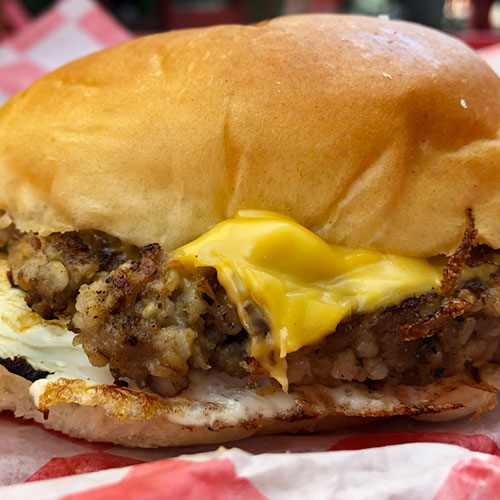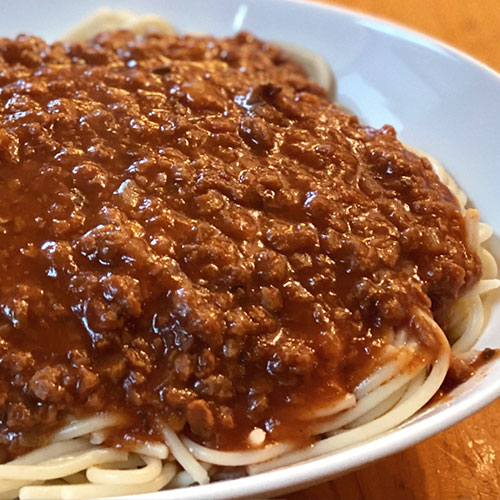Last week, the Wisconsin Department of Health Services went viral on Twitter.
It started with a notice advising the state’s residents to skip the raw meat sandwiches this holiday season. The internet roiled in disgust, incensed that adults would need to be told such a thing. For the rest of the week, the online masses had fun dunking on Sconnies for eating uncooked sloppy Joes at Christmastime. CNN took notice, reporting with dumbfounded matter-of-factness, and a grimacing Trevor Noah watched a Wausau man take a bite of a so-called cannibal sandwich on The Daily Show.
Twitter users tagged their friends in Wisconsin. Some were equally baffled, but others responded with versions of, “Oh, yeah, that’s a thing.” Cannibal sandwiches—also called raw meat, tiger meat, or wildcat—are not news to much of Wisconsin.
Neither is the health department’s warning, tweeted out for years without much response. (Last year’s advisory didn’t get a single retweet. This year’s has 2,600.) Maybe it’s because the department’s feed has become a resource for pandemic news and guidelines this year, bringing in legions of new followers who were alarmed by the all-too-casual talk of raw meat sandwiches. But as the sandwich has become a meme, Sconnies have been speaking up about its importance in the Badger State.
Twitter users tagged their friends in Wisconsin. Some were equally baffled, but others responded with versions of, “Oh, yeah, that’s a thing.” Cannibal sandwiches—also called raw meat, tiger meat, or wildcat—are not news to much of Wisconsin.
“I have family that eats this every year,” one Twitter user said, echoing dozens of others. “I’ve been eating them since I was 6,” a Facebook commenter replied. “I’m not stopping now… and will eat it on any day that ends in Y.”
Green Bay native and food writer Natalia Mendez remembers that cannibal burger—as they called it—was a mainstay at neighborhood Christmas potlucks. It wasn’t served in a sandwich, but more like a spread, with crackers or rye toast crisps.
For some reason, they say, you’d always find it in the garage. “It’s like blue collar steak tartare. It’s always this gray, browning hunk of raw beef. A good party would have onions and a pepper shaker nearby. The pink of the rawness would show through, because you would scoop it out and plop it on your plate with all your other stuff. I never thought about how weird it was until, like, I thought about how weird it was.”
Germans—and, to a lesser extent, Belgians—enjoy mettbrötchen, a traditional dish composed of raw ground pork that’s seasoned, spread on a roll, and often topped with raw onions. (In some areas, it’s called hackpeter.) Cannibal sandwich is an American translation of that dish, most prevalent in Wisconsin, where 42.3% of the population has roots in Germany. Folks also enjoy it in the Dakotas, where it is more commonly known as “tiger meat” and sometimes called “whistling burger” or “raw burger.” The “cannibal” name predates Wisconsin’s history of flesh-eating serial killers, though the synchronicity is now part of the dish’s macabre appeal.
Much of the visceral reaction to the Department of Heath Services tweet had to do with the image they chose, depicting a corrugated hunk of beef paste. Mendez insists that you have to use a high-quality piece of beef, ground fresh. Butcher shops throughout Wisconsin sell lean beef specifically for raw consumption, in line with USDA recommendations.
“I was very excited once [cannibal sandwiches] became a hot button topic, trending on Twitter, because this is such a niche thing that nobody talks about except for a small number of Wisconsin people,” says Caleb Kulich, a native of Stevens Point. Kulich was one of many who tried to redeem his home state’s reputation. He let loose an incensed Tweet clarifying that Sconnies don’t make cannibal sandwiches from hamburger. “I felt called to assure people that Wisconsin folks are not just grabbing frozen beef from the grocery store and eating it. We don’t do that. We’re not insane.”
Jill Numrich first tried cannibal beef when she was five years old, in Door County. She remembers the dish, prepared by her aunts on special occasions, being rich, though mild. Their sandwiches were open-faced, on rye. She trusted the quality of the raw beef because her family was so connected to the origins of their food.
“These are people who, if they’re not hunting their own meat, they know where it’s coming from,” she says. “You know, even down to the farm, how they’re cleaning it.” If anyone had ever gotten sick, the family would have harangued the butcher. That never happened. However, she points out, her husband did come down with food poisoning after eating steak tartare at a fancy restaurant in Minneapolis.
Still, the science is unambiguous: Eating raw meat is not good for your guts, even after careful preparation. A food safety specialist recently told Yahoo that the cannibal sandwich is “probably one of the riskier foods that are out there.” In 2013, authorities traced an outbreak of seventeen E. coli cases to a Badger State meat market selling ground beef for raw consumption, and the state health department cites seven other outbreaks dating back to 1986, the largest of which affected 150 people in December 1994.
That’s why Jen White hasn’t indulged in thirty years, though when she was growing up in the northern Wisconsin town of Rhinelander, her family ate cannibal sandwiches every Sunday after church. She stopped eating raw beef in med school, spooked by her parasitology courses. She still craves the taste from time to time. And she isn’t ashamed of those Sunday meals, she says, or the German tradition as interpreted in the Upper Midwest. People just like to punch down on the Badger State.
“All these cooking shows, they make steak tartare all the freakin’ time,” she says. “Why aren’t people freaking out about about that? It’s just because steak tartare is high-falutin’, and it’s French. This is basically common people food, and they’re just looking down on it.”




